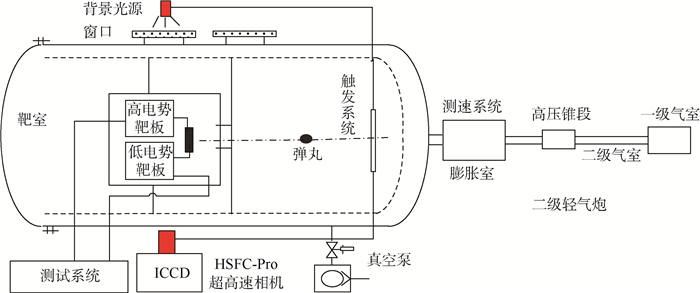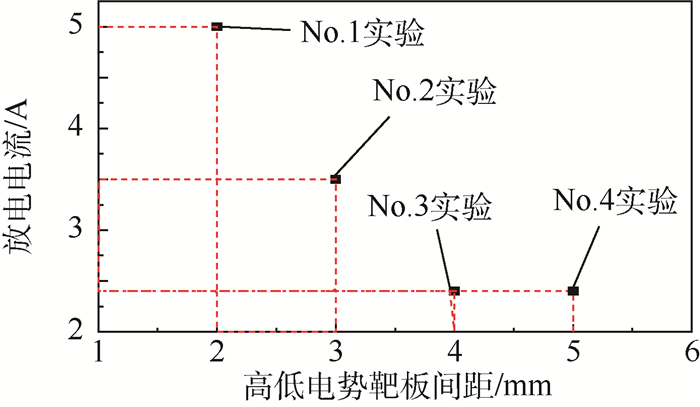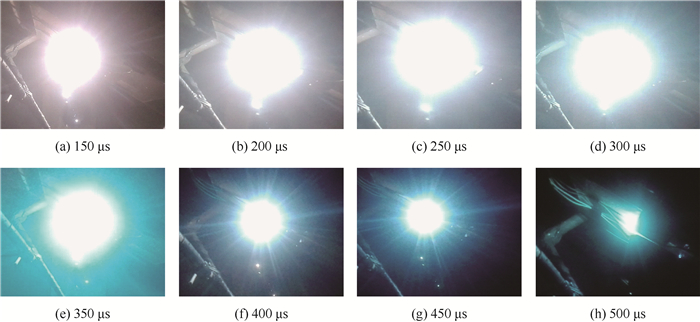Discharge induced by plasma during high-velocity impact on target plate with gradient potential
-
摘要:
针对在轨运行航天器在空间等离子体环境和空间带电粒子活动下诱发航天器表面梯度电势存在的客观现实,航天器在空间碎片的撞击下会诱发表面带电或深层电介质带电的航天器放电。为了在实验室模拟航天器表面存在电势差的真实情况,采用对航天器外表面分割的方法,在分割的表面间预留不同间距且在2靶板间加装电阻的方法创造具有梯度电势的高电势2A12铝板作为靶板。利用自行构建的梯度电势靶板的充放电测试系统、超高速相机采集系统和二级轻气炮加载系统,开展高速撞击梯度电势2A12铝靶的实验室实验。实验中,弹丸以入射角度为60°(弹道与靶板平面的夹角)、撞击速度约为3 km/s的条件撞击间距分别为2、3、4和5 mm的2A12铝高电势靶板,利用电流探针和电压探针采集放电电流和放电电压。实验结果表明:放电产生的等离子体形成了高电势与低电势靶板间的放电通道,且在梯度电势靶板间距分别为2、3 mm时诱发了一次放电,放电电流随高低电势靶板间间距的增加而减小;在梯度电势靶板间距分别为4、5 mm时诱发了二次放电,放电电流随高低电势靶板间间距的增加变化不明显。
Abstract:Based on the objective reality of gradient potential existence in spacecraft surface caused by charged particles in space plasma environment in the orbiting spacecraft, discharge of spacecraft with surface charging or deep dielectric charging would be induced by debris or meteoroids impacting. In order to simulate the existence of the spacecraft surface potential in the laboratory, method of spacecraft surface segmentation was used, different spacing is reserved between two adjacent surfaces, and resistance is added to create high-potential surface and high-potential gradient as a target in the segmentation of the surface for 2A12 aluminum plate. Potential gradient power supply circuit system, discharge test system and ultra-high speed camera photo acquisition system were built by ourselves, and combining with two-stage light gas gun loading system, we have carried out experiments on high-velocity impact on 2A12 aluminum target with gradient potential. In the experiments, high-potential 2A12 aluminum was used as the target with gaps of 2 mm, 3 mm, 4 mm and 5 mm between high-potential and low-potential 2A12 aluminum, the incidence angle (between projectile flying trajectory and target plane) of 60°, and the impact velocity of about 3 km/s. Voltage probe and current probes were used to acquire discharge voltage and current. The experimental results show that the plasma discharge is generated by forming a discharge channel between high-potential and low-potential target, the gaps with 2 mm and 3 mm evoke primary discharge, and the discharge current increases when the level of spacing decreases; the gaps with 4 mm and 5 mm induce the second discharge, and the discharge current does not change significantly when the spacing between high-potential and low-potential target increases.
-
表 1 实验基本参数
Table 1. Basic experimental parameters
实验编号 撞击速度/(km·s-1) 电势靶板间距/mm 电压探针编号 靶板的稳恒电压/V 电流探针编号 电路中的稳恒电流/A 靶室内真空压力/Pa No.1 3.08 2 VP1 298.0 CP1 3.64 40 CP2 3.01 CP3 2.98 No.2 3.05 3 VP1 297.5 CP1 3.57 40 CP2 2.94 CP3 3.02 No.3 3.05 4 VP1 298.2 CP1 3.46 39 CP2 2.94 CP3 3.10 No.4 2.98 5 VP1 297.4 CP1 3.58 38 CP2 3.02 CP3 2.91 -
[1] CRAWFORD D A. The production and evolution of plasma associated magnetic fields during hypervelocity impacts: Implications for planetary paleomagnetism[D]. Providence: Brown University, 1992. [2] ANDERSON B J, SMITH R E, ROBERT E. Natural orbital environment guidelines for use in aerospace vehicle development: NASA TM-4527[R]. Washington, D. C. : NASA, 1994. [3] TANG E L, ZHANG Q M, XIANG S H, et al.Triple Langmuir probe diagnosis of transient plasma created by hypervelocity impact[J]. International Journal of Applied Electromagnetic Mechanics, 2012, 38(2):117-125. [4] TANG E L, ZHANG Q M, ZHANG J.Preliminary study on magnetic induction intensity induced by plasma during hypervelocity impact[J]. Chinese Journal of Aeronautics, 2009, 22(4):387-392. doi: 10.1016/S1000-9361(08)60115-6 [5] TANG E L, LI Z B, ZHANG Q M, et al.Experimental research on light flash generated by high-velocity impact on solar array[J]. International Journal of Applied Electromagnetics and Mechanics, 2017, 54(4):569-581. doi: 10.3233/JAE-160108 [6] RUNCOM S K.Lunar magnetism, polar displacements and primeval satellites in the earth-moon system[J]. Nature, 1983, 304(5927):589-596. doi: 10.1038/304589a0 [7] GOLD T, SOTER S.Cometary impact and the magnetization of the Moon[J]. Planetary & Space Science, 1976, 24(1):45-54. [8] SRNKA L J. Spontaneous magnetic field generation in hypervelocity impacts[C]//Proceeding Lunar Science Conference. Houston: Harvard Publishing House, 1977, 8: 893-895. [9] BRUNDIN C L.Effects of charged particles on the motion of an earth satellite[J]. AMA Journal, 1963, 1(11):2529-2538. [10] ROBINSON C J. Introduction to plasma physics[M]. New York:Plenum Press, 1974. [11] LAI S T, MURAD E, MCNEIL W J.Hazards of hypervelocity impacts on spacecraft[J]. Spacecraft & Rockets, 2002, 39(1):106-114. [12] LAI S T.A review of critical ionization velocity[J]. Reviews of Geophys, 2001, 39(4):471-506. doi: 10.1029/2000RG000087 [13] CASWELL R D, MCBRIDE N, TAYLOR A.Olympus end of life anomaly-A perseid meteoroid impact event [J]. International Journal of Impact Engineering, 1995, 17:139-150. doi: 10.1016/0734-743X(95)99843-G [14] WILSON P F, MA M T, ONDREJKA A R.Fields radiated by electrostatic discharges[J]. IEEE International Symposium on Electromagnetic Compatibility, 1988, 33(1):179-183. [15] CRAWFORD D A, SCHULTZ P H.Laboratory observations of impact-generated magnetic fields[J]. Nature, 1988, 336(6194):50-52. doi: 10.1038/336050a0 [16] FUKUSHIGE S, AKAHOSHI Y, WATANABE K, et al.Solar-array arcing due to plasma created by space-debris impact[J]. IEEE Transactions on Plasma Science, 2008, 36(5):2434-2439. [17] AKAHOSHI Y, NAKAMURA T, FUKUSHIGE S, et al.Influence of space debris impact on solar array under power generation[J]. International Journal of Impact Engineering, 2008, 35(12):1678-1682. doi: 10.1016/j.ijimpeng.2008.07.048 [18] HARANO T, MACHIDA Y, FUKUSHIGE S, et al.Preliminary study on sustained arc due to plasma excited by hypervelocity impact of space debris on the solar array coupon[J]. International Journal of Impact Engineering, 2006, 33(1):326-334. [19] TOYODA K, ASO S, KYOKU T, et al.Proposal of a current regulative diode for power supply in sustained arc test[J]. IEEE transactions on Plasma Science, 2006, 34(5):1967-1972. doi: 10.1109/TPS.2006.881933 [20] TANG E L, XU M Y, ZHANG Q M, et al.Research on the ionization degree of the plasma generated by 2A12 aluminum target during hypervelocity impact[J]. IEEE Transactions on Plasma Science, 2016, 44(8):1333-1340. doi: 10.1109/TPS.2016.2580909 [21] TANG E L, ZHANG L J, ZHANG Q M, et al.Discharges of plasma induced by hypervelocity impact on the solar array with different substrate structures[J]. International Journal of Applied Electromagnetics and Mechanics, 2016, 51(3):337-347. doi: 10.3233/JAE-150115 [22] TANG E L, WANG H L, XIA J, et al.Experimental study on plasma discharge induced by high-velocity impact solar array associated with projectile incidence angles[J]. International Journal of Applied Electromagnetics and Mechanics, 2016, 51(2):107-117. doi: 10.3233/JAE-150119 -








 下载:
下载:












